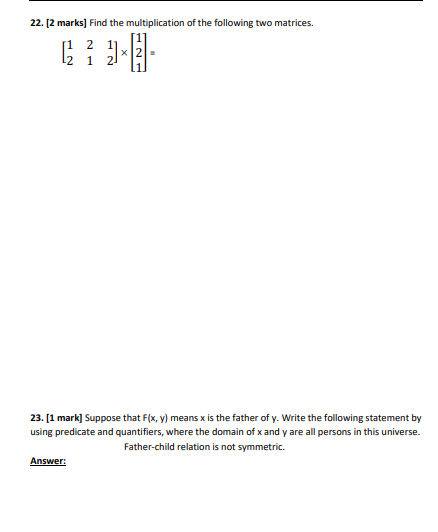Find the multiplication of the following two matrices. Suppose that F(x, y) means x is the father of y. Write the following statement by using predicate and quantifiers, where the... Find the multiplication of the following two matrices. Suppose that F(x, y) means x is the father of y. Write the following statement by using predicate and quantifiers, where the domain of x and y are all persons in this universe. Father-child relation is not symmetric.

Understand the Problem
The question is asking to perform the multiplication of two matrices which involves matrix multiplication rules. It also asks for a formal logical representation of a relation involving predicates and quantifiers, specifically relating to familial relationships.
Answer
The result of the matrix multiplication is: $$ \begin{pmatrix} 3 & 4 \\ 3 & 5 \\ \end{pmatrix} $$
Answer for screen readers
The product of the two matrices is:
$$ \begin{pmatrix} 3 & 4 \ 3 & 5 \ \end{pmatrix} $$
Steps to Solve
- Identify the matrices
The given matrices are:
$$ A = \begin{pmatrix} 1 & 2 \ 2 & 1 \ \end{pmatrix}, \quad B = \begin{pmatrix} 1 & 2 \ 1 & 1 \ \end{pmatrix} $$
- Determine the size of the resulting matrix
Matrix $A$ is a $2 \times 2$ matrix and matrix $B$ is also a $2 \times 2$ matrix. The resulting matrix, when multiplying two matrices of size $m \times n$ and $n \times p$, will be a matrix of size $m \times p$. Thus, the resulting matrix will be $2 \times 2$.
- Perform matrix multiplication
To find the entry in row $i$ and column $j$ of the resulting matrix $C$, we use the formula:
$$ C_{ij} = \sum_{k=1}^{n} A_{ik} B_{kj} $$
For our case:
-
For $C_{11}$: $$ C_{11} = 1 \cdot 1 + 2 \cdot 1 = 1 + 2 = 3 $$
-
For $C_{12}$: $$ C_{12} = 1 \cdot 2 + 2 \cdot 1 = 2 + 2 = 4 $$
-
For $C_{21}$: $$ C_{21} = 2 \cdot 1 + 1 \cdot 1 = 2 + 1 = 3 $$
-
For $C_{22}$: $$ C_{22} = 2 \cdot 2 + 1 \cdot 1 = 4 + 1 = 5 $$
- Compile results into the resulting matrix
The resulting matrix $C$ is:
$$ C = \begin{pmatrix} C_{11} & C_{12} \ C_{21} & C_{22} \ \end{pmatrix} = \begin{pmatrix} 3 & 4 \ 3 & 5 \ \end{pmatrix} $$
The product of the two matrices is:
$$ \begin{pmatrix} 3 & 4 \ 3 & 5 \ \end{pmatrix} $$
More Information
Matrix multiplication is not commutative, meaning the order of multiplication matters. In this case, we calculated the product directly using element-wise multiplication and summation based on the rows of the first matrix and the columns of the second.
Tips
- Confusing the order of matrix multiplication; always remember the order is crucial.
- Forgetting to sum all products in the calculation of each entry.
AI-generated content may contain errors. Please verify critical information